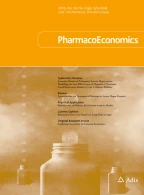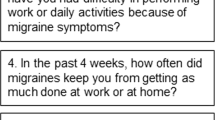MSQ: Migraine-Specific Quality-of-Life Questionnaire

MSQ, the 16-item Migraine—Specific Quality—of—Life Questionnaire (Version 1.0), was developed by Glaxo Wellcome Inc. to assess the effect of migraine and its treatment on patients’ health—related quality of life (HR-QOL). The MSQ was hypothesised to measure 3 meaningful dimensions: (i) Role Function—Restrictive; (ii) Role Function—Preventive; and (iii) Emotional Function. The objective of this research was to further investigate the number of dimensions as well as the items contained in each dimension through principal components factor analysis of clinical trial data. Secondary objectives were to determine whether the factor structure changed in post—treatment visits compared with screening visits, to make recommendations for coding the MSQ when the patient did not have a migraine in the previous 4 weeks, and to modify the MSQ if so indicated by this research. Results supported the existence of 3 distinct factors which agreed strongly with the hypothesised dimensions. The analysis of post—treatment data suggested that the underlying factor structure of the MSQ varies as a result of treatment. Based on evaluations of the ‘did not have a migraine’ response, it was concluded that it be dropped from the MSQ. All these changes have been incorporated into MSQ (Version 2.0) which is being evaluated in studies to determine if its psychometric properties are different than the properties of the previous version.
This is a preview of subscription content, log in via an institution to check access.
Subscribe and save
Springer+ Basic
€32.70 /Month
- Get 10 units per month
- Download Article/Chapter or eBook
- 1 Unit = 1 Article or 1 Chapter
- Cancel anytime
Buy Now
Price includes VAT (France)
Instant access to the full article PDF.
Rent this article via DeepDyve
Similar content being viewed by others

Validity and reliability of the Greek Migraine-Specific Quality of Life Questionnaire (MSQ Version 2.1-GR)
Article Open access 15 July 2024

Migraine-Specific Quality of Life Questionnaire Chinese version 2.1 (MSQv2.1-C): psychometric evaluation in patients with migraine
Article Open access 24 June 2019

Content validity of the Migraine-Specific Quality of Life Questionnaire version 2.1 electronic patient-reported outcome
Article Open access 11 July 2019
References
- Stewart WF, Lipton RB, Celentano DD, et al. Prevalence of migraine headache in the United States: relation to age, income, and other sociodemographic factors. JAMA 1992; 267: 64–9 ArticlePubMedCASGoogle Scholar
- Stang PE, Osterhaus JT. Impact of migraine in the United States: data from the National Health Interview Survey. Headache 1993; 33: 29—35 Google Scholar
- Solomon GD, Skobieranda FG, Gragg LA. Quality of life and well-being of headache patients: measurement by the medical outcomes study instrument. Headache 1993; 33: 351–8 ArticlePubMedCASGoogle Scholar
- Osterhaus JT, Townsend RJ, Gandek B, et al. Measuring the functional status and well-being of patients with migraine headache in the U.S. Headache 1994; 34: 337–43 ArticlePubMedCASGoogle Scholar
- Soloman GD, Skobieranda FG, Gragg LA. Does quality of life differ among headache diagnoses: analysis using the Medial Outcomes Study Instrument. Headache 1994; 34: 143–7 ArticleGoogle Scholar
- Jhingran P, Osterhaus JT, Miller DW, et al. Development and validation of the Migraine-Specific Quality of Life Questionnaire. Headache 1998; 38: 295–302 ArticlePubMedCASGoogle Scholar
- LaVange LM, Helms RW. Factor analyses of Glaxo Wellcome Pharmacoeconomic Research Migraine Specific Questionnaire Data: project final report. Chapel Hill (NC): Rho Inc., 1995 Google Scholar
- Adelman JE, Sharfman M, Johnson R, et al. Impact of oral sumatriptan on workplace productivity, health related quality of life, health care use, and patient satisfaction with medication in nurses with migraine. Am J Manage Care 1996; 2: 1407–14 Google Scholar
- Morrison DF. Multivariate statistical methods. New York: McGraw-Hill, 1979 Google Scholar
- Basilevsky A. Statistical factor analysis and related methods, theory and applications. New York: John Wiley and Sons Inc., 1994 Google Scholar
- SAS Institute Inc. SAS stat user’s guide. Version 6. 4th ed., vol. 1. Cary (NC): SAS Institute Inc., 1989 Google Scholar
- SAS Institute Inc. SAS stat user’s guide. Version 6. 4th ed., vol. 2. Cary (NC): SAS Institute Inc., 1989 Google Scholar
- Helms RW, MacDougall JE. Graphical presentation of covariance matrices from principal components and factor analysis models. Chapel Hill (NC): Department of Biostatistics, University of North Carolina, 1997. Institute of Statistics Mimeo Series no.: 2175 Google Scholar
Author information
Authors and Affiliations
- Glaxo Wellcome Inc., Five Moore Drive, Research Triangle Park, Durham, North Carolina, 27709, USA Priti Jhingran & David W. Miller
- Quintiles Inc., Research Triangle Park, Durham, North Carolina, USA Sonia M. Davis & Lisa M. LaVange
- Rho Inc. and Department of Biostatistics, University of North Carolina, Chapel Hill, North Carolina, USA Ronald W. Helms
- Priti Jhingran




